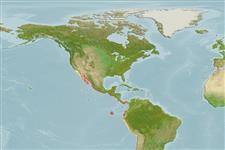>
Elopiformes (Tarpons and tenpounders) >
Elopidae (Tenpounders)
Etymology: Elops: Greek, ellops = a kind of serpent (Ref. 45335).
More on author: Regan.
Environment: milieu / climate zone / depth range / distribution range
экология
морской; солоноватоводный; мигрирует в океане (Ref. 51243); пределы глубины 0 - 10 m (Ref. 96339). Subtropical; 36°N - 19°S, 122°W - 70°W (Ref. 118622)
Eastern Pacific: Mandalay Beach, southern California, USA to Peru, including the Gulf of California.
Size / Вес / Возраст
Maturity: Lm ? range ? - ? cm
Max length : 91.0 cm TL самец/пол неопределен; (Ref. 28050); common length : 50.0 cm TL самец/пол неопределен; (Ref. 9297)
Краткое описание
определительные ключи | морфология | морфометрия
колючие лучи спинного плавника (общее число) : 0; членистые (мягкие) лучи спинного плавника (общее число) : 20 - 27; колючие лучи анального плавника: 0; членистые (мягкие) лучи анального плавника: 12 - 18; позвонки: 78 - 82. Body slender and elongate; mouth large and terminal; bony plate present between branches of lower jaw; branchiostegal rays very numerous (25 to 35); fins lacking spines; lower branch of first gill arch with 16 to 20 gill rakers; scales very small, 100 to 120 in the lateral line; back dark blue-green to light brown; flanks silvery with slight yellow highlights; fins slightly yellowish (ref. 55763). Caudal rays: principal (10+8-9), procurrent (upper:8, lower: 8)
Branchiostegal rays: 23-35
Occur in schools in shallow inshore areas. Penetrate lagoons and estuaries (Ref. 9297). Feed on fish and penaeids (Ref. 50313). Spawning probably occur in the open sea and the transparent larvae migrate towards coastal areas (Ref. 9297). Struggle vigorously when caught on hooks and lines (Ref. 9297). Low commercial value due its numerous spines (Ref. 9297).
Life cycle and mating behavior
Maturities | размножение | Spawnings | Egg(s) | Fecundities | личинки
Eschmeyer, W.N., E.S. Herald and H. Hammann, 1983. A field guide to Pacific coast fishes of North America. Boston (MA, USA): Houghton Mifflin Company. xii+336 p. (Ref. 2850)
Статус Красного Списка МСОП (Ref. 130435)
Угроза для людей
Harmless
Использование человеком
рыболовство: не имеет хозяйственного значения; объект спортивного рыболовства: да
дополнительная информация
инструменты
Специальные отчеты
Скачать в формате XML
ресурсы в Интернет
Estimates based on models
Preferred temperature (Ref.
123201): 20.4 - 29.1, mean 25.1 °C (based on 257 cells).
Phylogenetic diversity index (Ref.
82804): PD
50 = 0.5176 [Uniqueness, from 0.5 = low to 2.0 = high].
Bayesian length-weight: a=0.00589 (0.00256 - 0.01357), b=2.99 (2.79 - 3.19), in cm total length, based on LWR estimates for this (Sub)family-body shape (Ref.
93245).
Trophic level (Ref.
69278): 4.1 ±0.70 se; based on food items.
Fishing Vulnerability (Ref.
59153): High vulnerability (56 of 100).
Nutrients (Ref.
124155): Calcium = 57.4 [34.6, 127.5] mg/100g; Iron = 1.01 [0.59, 1.75] mg/100g; Protein = 17.7 [15.2, 20.7] %; Omega3 = 0.24 [0.13, 0.45] g/100g; Selenium = 17.6 [8.6, 38.9] μg/100g; VitaminA = 9.51 [3.42, 26.87] μg/100g; Zinc = 0.776 [0.556, 1.096] mg/100g (wet weight);
